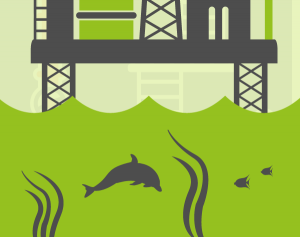The offshore industry should use joined up processes and technology to drive regulatory compliance, says Dynama
The offshore industry has a duty of care to the environment and crew safety. Lee Clarke at Dynama outlines a 3-point plan to educate staff and meet regulation
Of course, the effects of major health and safety incidents go beyond lost lives: they have a devastating impact on the surrounding environment. In just the same way health and safety became a serious issue following the Deepwater Horizon tragedy, the environment has today become a hot topic and priority for many offshore organizations, heightened, no doubt, by the prominence of issues such as climate change on the global political agenda.
As a result, improvements have been made in the way that atmospheric emissions along with chemical and oily discharges are measured and regulators have a great deal of influence. For example in the UK, the Environment Agency (EA)[i] is the environmental regulator for all onshore oil and gas operations; the Oil & Gas Authority (OGA)[ii] has recently succeeded the Department of Energy & Climate Change (DECC) as the regulator of the offshore and onshore oil and gas sector in the UK; and the Department for Business, Energy and Industrial Strategy (BEIS)[iii] is responsible for setting energy and climate change mitigation policies, and establishing the framework for achieving the policy goals in those areas.
Two major challenges
The offshore industry is faced with many challenges, particularly when it comes to staffing and associated resources and the main two challenges are:
•The international nature of the industry which makes management of crew and resources difficult. Often a divergent set of personnel (on the payroll and contractors) along with the vessels and complex machinery they operate are scattered on-and-offshore, in different continents and in multiple time zones
•The best talent is scarce and expensive. The UK Continental Shelf (UKCS), a mature oil producing area, has been negatively affected by the sustained period of low oil and gas prices since 2014. This has led to an estimated 15% reduction in the workforce supported by the oil and gas industry, often highly skilled and with specialist knowledge.[iv]
In the context of these two significant hurdles, what should offshore companies do to prepare themselves to meet stiff regulatory challenges? Firstly, staff at all levels working in the offshore industry need to understand what the regulations are, how they apply to their individual job roles and what their responsibilities should be. Secondly, the emphasis should be on encouraging a joined-up approach to health, safety and the environment by introducing a robust set of processes for all to follow. Finally, these processes should be wrapped up with automated technology to help reduce the administrative burden, improve accuracy and aid compliance with industry legislation.
Three steps to stay on track
Here, we offer a 3-point workforce planning framework that focuses on efficient, joined-up processes backed up with workforce planning technology to help meet ever stricter environmental and health and safety regulation:
1.Track your training – so many organizations waste money on a blanket approach to training that is totally unsuited to the specialist skills required in the offshore industry. This is a situation that can be avoided using the latest workforce deployment solutions. With a virtual central library of accurate staff records at your fingertips, it’s easy to track what training each member of staff has had, when certificates expire and to identify then fill any gaps that come up with meaningful training programs
2.Up-to-date skills matrix at the touch of a button – most organizations today will have some sort of skills matrix but to maximize its full potential, the skills matrix should be integrated into planning and scheduling processes at the click of a button. This will ensure that the right crew are assigned to the right projects, and skills gaps are forecast ahead of time not just in time or when it is too late.
3.Good communication makes all the difference – take joined up thinking one step further by combining the benefits of one central workforce planning solution with a sound communications strategy to keep staff informed of the latest regulatory changes as they happen. All too often, offshore projects on barges at sea can become black boxes. Avoid this by encouraging constant synchronization of planning and crewing changes offshore and shore-side, particularly important for companies that work in the North Sea, for example, where conditions are especially harsh and communications are critical for safety.
Finally, acknowledge you can’t always do it yourself. Take up the professional services offered by your technology provider and work with them as an extension of your own team. They often have the proven expertise both technically and commercially to maximize, adapt and continuously improve your workforce planning implementation, whatever the environmental and regulatory landscape.
Lee Clarke is Regional Director, Northern Hemisphere, at Dynama.
[i] www.environment-agency.gov.uk
[ii] www.gov.uk/government/organisations/oil-and-gas-authority
[iii] www.gov.uk/government/organisations/department-for-business-energy-and-industrial-strategy
[iv] Thomson Reuters Practical Law: https://uk.practicallaw.thomsonreuters.com/
Mary Phillips
PR Artistry
+44 (0) 1491 845553
email us here
Legal Disclaimer:
EIN Presswire provides this news content "as is" without warranty of any kind. We do not accept any responsibility or liability for the accuracy, content, images, videos, licenses, completeness, legality, or reliability of the information contained in this article. If you have any complaints or copyright issues related to this article, kindly contact the author above.


